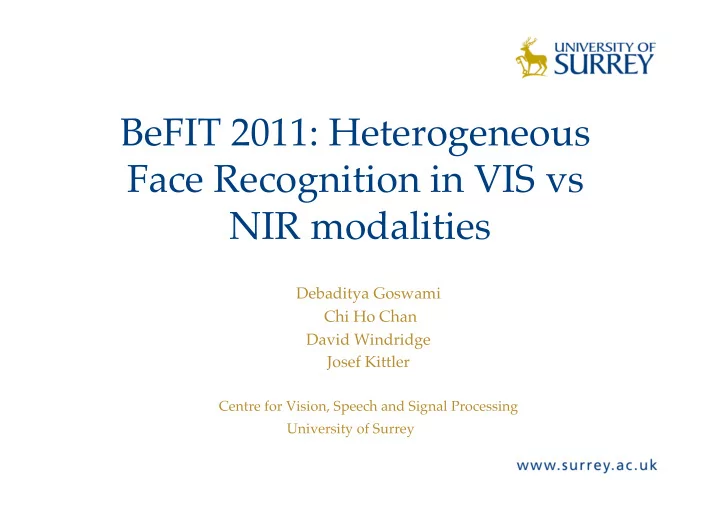

BeFIT 2011: Heterogeneous Face Recognition in VIS vs NIR modalities � Debaditya Goswami � Chi Ho Chan � David Windridge � Josef Kittler � Centre for Vision, Speech and Signal Processing � �� University of Surrey
Contents � • Introduction � – Motivation for Cross Spectral Face Recognition � – Motivation for Standardised testing � • Dataset � – Acquisition, sample size, � – Protocol: Configuration I and II � • Methodology � – Preprocessing, Feature Extraction, Dimensionality Reduction, CCA projection � • Experiments � – Overview of algorithmic combinations � • Results � • Discussion � • Conclusions �
Face Recognition � Natural Variation � G ALLERY � P ROBE � Occlusion � D ECISION (Y ES /N O ) � Aging � Face Recognition � (Challenges) � Illumination Variation �
Illumination Invariant Face Recognition � I LLUMINATION I NVARIANT F ACE R ECOGNITION � Spatial 2D Spectral Methods � Normalisation � Methods � Unimodal 3D Re-lighting � Photometric � Hyper-Spectral � Cross-Spectral � Spectral � NIR-VIS � • Model-based Approaches � • Algorithmic Approaches �
Cross Spectral Face Matching � • Matching NIR probe images against a set of VIS gallery images � • Scenarios – Airports, building entry points � • NIR : 800 – 1050 nm band � • Spectral Differences � − Diffusion of features in NIR ( Subsurface Scattering ) � − Light response dictating distinct facial morphology � VIS face images(top) and corresponding − Texture discrepancies � NIR images (bottom) �
Existing Heterogeneous Face Recognition Systems � • Subspace projection (Lin et al. 2006) � • Canonical Correlation Analysis as a form of feature mapping (Li et al. 2007) � • Difference of Gaussian filtering (Liao et al. 2009) � • LBP feature representation (Liao et al. 2007, Chen et al. 2009) �
Testing Procedure � Total Vis Images � Nir Images � Database � Subjects � 100 � 400 � 400 � HFB � 48 � 192 � 192 � TINDERS � 50 � 100 � 90 � Chen et al. CVPR 2009 � • Multiple protocols with several different datasets �
Pose and Illumination Cross Spectral (PICS) Dataset �
Protocol � • V trn – 175 subjects x 3, 525 images � • N trn – 186 Subjects x 3, 558 images � • Vt st - 255 Subjects, 1545 images � • N tst – 244 Subjects, 1563 images �
Methodology � Feature Subspace Preprocessing Classification Extraction Projection • Raw � • Sequential • Nearest Chain (SQ) � • Local Binary • PCA/LDA � Neighbour � • Single Scale • CCA � • Chi-Squared � Patterns � Retinex (SSR) � • Normalised • Self-Quotient Correlation � Image (SQI) �
Mapping: Canonical Correlation Analysis � Where � and � are are the within-set covariance matrices , while � is the between-set covariance matrix . �
Configuration I Experiments �
Photometric Normalisation Results � I a I b
Supervised vs Unsupervised Performance �
Configuration II �
CCA Recognition Performance � II a II b
Fusion Experiments � • Performance plateau at 5 -7 algorithmic combinations � • SQ preprocessing (DoG-based) present in every single top- performing combination � • Use of more than 7-8 combinations degrades performance �
Discussion � • Supervised vs Unsupervised Process chains � • Importance of Pre-processing techniques � • Over-fitting of CCA model projections � • Fusion experiments achieve peak performance � – Importance of SQ (DoG-based) in top performing permutations �
Conclusions � • Standardised testing for cross spectral datasets � • Dataset containing pose and illumination variation � • Baseline algorithms to establish a true evaluative framework � • Importance of projection model, and probe-gallery combinations �
Contact Details � • http://www.ee.surrey.ac.uk/CVSSP/ Datasets (soon!) � • Email debadityag@gmail.com or � c.chan@surrey.ac.uk � – Name � �� – Organisation �
Recommend
More recommend